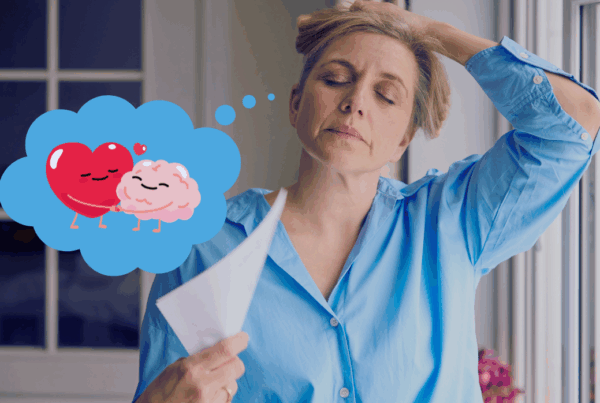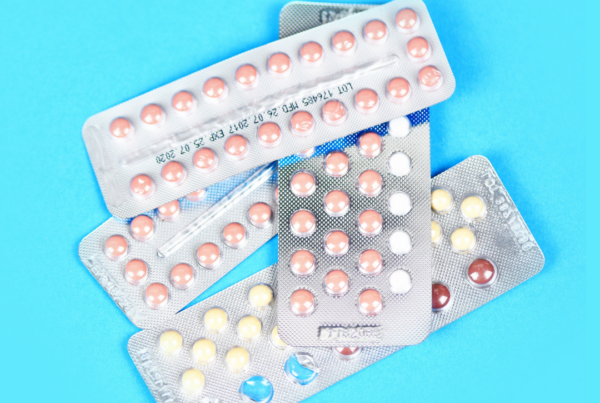early perimenopause stage
What’s happening now?
During early perimenopause – you ovulate (release eggs) less often but your fertility window is still open (you can still get pregnant). You have erratic hormone levels with less progesterone and higher levels of unchecked oestrogen. This is because cycles without ovulation have a less supported luteal phase (the second half of the cycle) where there is less progesterone produced to organise your womb lining and your period.
Perimenopause is truly the storm season for hormones but the symptoms won’t last forever.
Perimenopause is the time leading up to your last period and the next 12 months after that. (“Menopause” is actually the day 12 months after your last period, which is a pretty unhelpful definition).
Early perimenopause commonly starts in your 40’s. Technically, ‘early perimenopause’ starts when your period becomes irregular with a variation of more than 7 days. Well before that, however, you can develop symptoms related to hormonal changes and it helps to recognise this so you don’t start treatments that are not directed at their root cause.
If you are experiencing spotting between periods, don’t have any symptoms or are under 40, you should check with a doctor whether there may be another cause for the changes in the nature of your period or if you are entering an early menopause.
Mental health problems can also surface now, particularly where there is a background of severe premenstrual mood changes, postnatal depression or a history of clinical depression. It is valuable to consider whether hormone imbalance is contributing, even causing, mood changes as rebalancing hormones can help as a first treatment choice.
There are some symptoms that can arise from these anovulatory cycles and hormone imbalance
-
Migraines and headaches
-
Disrupted sleep
-
Mood changes
-
Irritability
-
Anxiety
-
Joint and muscle pains
-
Hot flushes, night sweats
-
Breast tenderness
-
Palpitations
-
Weight gain / shift
-
Vaginal dryness
-
Low libido
-
Nerve symptoms like dizziness, odd feelings in your hands and feet
Best treatment for this stage
Now is a perfect time to start getting your lifestyle in order – be active, eat well, get enough sleep , manage your stress.
If you need more help, hormone treatment can be very effective but this needs to be tailored to your personal symptoms and contraceptive needs. It also needs to be adjusted as you evolve further through the stages.
Healthy habits will make you feel more energetic and brighten your mood in the short term and also protect your health and wellbeing in the years to come. They may also reduce the intensity of menopausal symptoms later.
If you are using the oestrogen containing pill (combined oral contraceptive pill, COCP) for contraception, it can continue to be a great option that not only provides contraception but will control many potential perimenopausal symptoms. This can safely be used in women without contraindications, but should be reassessed if over 50 years, over 35 years and still smoking or if your BMI is over 35.
The COCP is also a great first line hormone treatment for women experiencing symptoms of hormone changes during early perimenopause as it overrides brain – ovary communication, provides stable levels of sex hormones, controls heavy or irregular bleeding AND offers contraception at the same time. There are different types of pills depending on your symptoms and if you have been sensitive to pills or other hormonal contraceptives in the past. The progesterone only pill also overrides the brain-ovary communication and prevents ovulation, but as time progresses, you may experience symptoms of insufficient oestrogen.
During this stage, you may experience cyclic symptoms – worse in the week or 2 before your period. This may indicate insufficient luteal phase progesterone to counterbalance oestrogen. Cyclic progesterone therapy may be helpful in this situation.
Standard MHT may also be tried but may be less effective than later in your menopause journey. This is because you may already have problematic high levels of oestrogen.
Women in this stage can often find their period getting heavy and potentially causing some iron loss and fatigue. The Mirena IUD is great for contraception and controlling heavy bleeding. It does make it difficult to assess your menopause stage if you are in the majority of women who stop bleeding. The Mirena can be used to protect the endometrium when using oestrogen hormone therapy.
Some symptoms such as mental health problems and aggravation of migraines, are very effectively treated with hormonal medication. Sometimes these are planned to support your natural cycle or maybe even override your natural cycle (eg the pill).
What’s up next?
“Late Perimenopause” is ahead of you.
In late perimenopause, your cycle will become more irregular with over 60 days between periods. The flow is altered and there may even be flooding where the bleeding is very heavy.
Symptoms will progressively be due to reduced oestrogen levels in addition to oestrogen / progesterone imbalance and include more flushes and sweats.
A note on blood tests
Unfortunately, blood tests are not very helpful as hormones vary from day to day, week to week, cycle to cycle. Your period, age and symptoms are usually enough to estimate your stage.
If there is doubt as to the cause of your period changes or if you are younger than 45 and are not getting a period, your doctor may order a series of blood tests to explore your cycle and exclude other conditions impacting it.
The hormonal blood tests offer clues but are frequently insufficient to make a clear diagnosis until menopause has been established (there has been no period for 12 months).
This information is for general educational purposes only and does not constitute medical advice. Please see your health professional for advice that is personalised to you.
Key take aways
During early perimenopause stage your period is becoming irregular by more than 7 days. Your flow may also have changed.
There may be symptoms of hormonal imbalance such as mood changes, headaches, sleeplessness, palpitations, and occasionally hot flushes.







